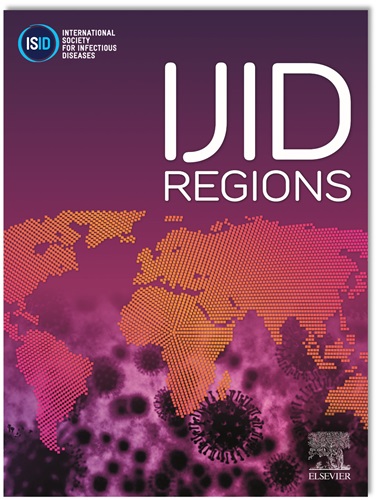Population-level respiratory virus–virus interactions, Puerto Rico, 2013-2023
IF 4.3
2区 医学
Q1 INFECTIOUS DISEASES
引用次数: 0
Abstract
Background
Understanding virus–virus interactions is important for evaluating disease transmission and severity. Positive interactions suggest concurrent circulation, while negative interactions indicate reduced transmission of one virus when another is prevalent. This study examines interactions among seven respiratory viruses using a Bayesian approach that accounts for seasonality and long-term trends.
Methods
We analyzed data from 43,385 acute febrile illness cases in the Sentinel Enhanced Dengue Surveillance System in Puerto Rico (2013-2023). Viruses studied included influenza A (IAV), influenza B (IBV), respiratory syncytial virus (RSV), human parainfluenza viruses 1 and 3 (HPIV-1, HPIV-3), human adenovirus (HAdV), and human metapneumovirus (HMPV). Wavelet coherence analysis investigated synchronous or asynchronous viral co-variation, while a Bayesian hierarchical model estimated pairwise interactions.
Results
Among 43,385 participants, 26.0% tested positive for at least one virus, with IAV (9.5%), HAdV (4.1%), RSV (3.6%), and IBV (3.6%) being most frequent. Coinfections occurred in 0.5% of cases, often involving HAdV. Wavelet coherence identified significant synchronization among RSV/HMPV, HPIV-1/HMPV, and other virus pairs, with minimal coherence during the COVID-19 pandemic. Bayesian modeling suggested five virus–virus associations: four positive (RSV/HPIV-3, HMPV/HPIV-1, IBV/HAdV, IBV/HMPV) and one negative (IAV/HAdV). However, when restricting the analysis to the prepandemic period, fewer associations remained statistically credible.
Conclusion
Respiratory viruses in Puerto Rico demonstrate patterns of co-circulation that may reflect complex interactions, but these associations appear context-dependent. Findings highlight the need for continued surveillance to better understand virus–virus dynamics and their implications for public health interventions.
2013-2023年波多黎各人口水平呼吸道病毒相互作用
背景:了解病毒与病毒之间的相互作用对于评估疾病传播和严重程度非常重要。积极的相互作用表明同时传播,而消极的相互作用表明当另一种病毒流行时,一种病毒的传播减少了。本研究使用贝叶斯方法研究了七种呼吸道病毒之间的相互作用,该方法考虑了季节性和长期趋势。方法:我们分析了波多黎各哨兵加强登革热监测系统(2013-2023)中43,385例急性发热性疾病病例的数据。研究的病毒包括甲型流感(IAV)、乙型流感(IBV)、呼吸道合胞病毒(RSV)、人副流感病毒1型和3型(HPIV-1、HPIV-3)、人腺病毒(hav)和人偏肺病毒(HMPV)。小波相干分析研究同步或异步病毒共变,而贝叶斯层次模型估计两两相互作用。结果:在43,385名参与者中,26.0%的人至少检测出一种病毒阳性,其中IAV(9.5%)、hav(4.1%)、RSV(3.6%)和IBV(3.6%)最为常见。合并感染发生在0.5%的病例中,通常涉及hav。小波相干性发现RSV/HMPV、HPIV-1/HMPV和其他病毒对之间存在显著的同步,在COVID-19大流行期间一致性最小。贝叶斯模型显示了5种病毒关联:4种阳性(RSV/HPIV-3、HMPV/HPIV-1、IBV/ hav、IBV/HMPV)和1种阴性(IAV/ hav)。然而,当将分析限制在大流行前时期时,在统计上可信的关联较少。结论:波多黎各的呼吸道病毒显示出可能反映复杂相互作用的共循环模式,但这些关联似乎依赖于环境。研究结果强调需要继续进行监测,以便更好地了解病毒动力学及其对公共卫生干预的影响。
本文章由计算机程序翻译,如有差异,请以英文原文为准。
求助全文
约1分钟内获得全文
求助全文
来源期刊
CiteScore
18.90
自引率
2.40%
发文量
1020
审稿时长
30 days
期刊介绍:
International Journal of Infectious Diseases (IJID)
Publisher: International Society for Infectious Diseases
Publication Frequency: Monthly
Type: Peer-reviewed, Open Access
Scope:
Publishes original clinical and laboratory-based research.
Reports clinical trials, reviews, and some case reports.
Focuses on epidemiology, clinical diagnosis, treatment, and control of infectious diseases.
Emphasizes diseases common in under-resourced countries.

 求助内容:
求助内容: 应助结果提醒方式:
应助结果提醒方式:


